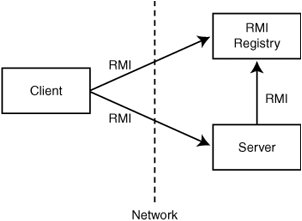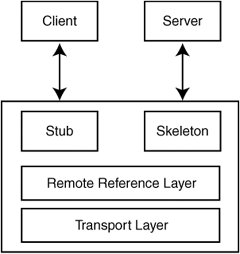Brief Overview of Java RMI
In case RMI is new to you, it's worthwhile to get a brief overview of the technology before moving into the details of using RMI with Quartz. If you're completely comfortable with RMIand, specifically, Java RMIfeel free to skip this material.
RMI is a mechanism that enables an object in one address space to communicate with objects in a different address space. These two address spaces can exist on the same machine or on entirely different ones. In general, you can think of RMI as an object-oriented Remote Procedure Call (RPC) mechanism.
RMI is not specific to Java, but Java does have its own version: Java RMI, which is released and supported by Sun (http://java.sun.com/products/jdk/rmi) as part of its Java SDK. Java RMI allows objects running in one JVM to communicate with and invoke methods on objects running in a second. These two JVMs can be running on the same machine or, more interestingly, on different ones. They might even be running on different platforms. For example, one JVM might be running on a Windows box, while the second runs on Linux. With Java RMI, it really doesn't matter. Figure 9.1 illustrates this scenario.
Figure 9.1. Java RMI enables developers to create distributed applications.

RMI is based on the principle of separation of responsibility. Interface definition is separated from the implementation. This coincides nicely with the goal of RMI: to allow a client, which is primarily concerned with the interface definition, to be separated (possibly physically) from the implementation of that interface definition. In order words, the client has an interface on which it can invoke the service call, while the implementation of that service lives on another machine. Figure 9.2 illustrates this separation within the Java programming language.
Figure 9.2. Java supports separating the service interface from the implementation.

When the RMI client invokes a method on the object, it is really invoking a method on a proxy object located in the client JVM. This proxy object knows how to communicate with the object located on the server. All communication, including values being passed to the server object and returned from it, occurs through the proxy object. This is shown in Figure 9.3.
Figure 9.3. All communication from the client to the server goes through the proxy object.

Components of a Java RMI Application
Every Java RMI application consists of three components:
- The RMI server program
- The RMI client program
- The RMI Object Registry
The RMI Server
The RMI server is responsible for creating the server object (which the client invokes methods on) and making the object available to remote clients. The RMI server runs in a standard JVM. The server objects are also regular Java objects and can be invoked locally as well as remotely.
The RMI Client
The RMI client is a Java program that (typically) runs in a separate JVM from the server; it might be on the same physical machine as the RMI or distributed on a separate machine. The client gets a reference to the server object by looking it up in the RMI Registry.
The RMI Object Registry
The RMI Object Registry is used by both the RMI client and server. When the server wants to make an object available to remote clients, it registers the object (along with a unique name) with the Registry. After a server object has been registered, RMI clients and methods invoked on the object can look it up.
Scheduling in the Enterprise
- What Is Job Scheduling?
- Why job Scheduling Is Important
- Uses for Job Schedulers in the Enterprise
- Uses for Job Schedulers in NonEnterprise
- Job scheduling Versus Workflow
- What about Alternative Solutions?
Getting Started with Quartz
- Getting Started with Quartz
- History of the Quartz Framework
- Downloading and Installing Quartz
- Building Quartz from Source
- Getting Help from the Quartz Community
- Whos Using Quartz?
Hello, Quartz
- Hello, Quartz
- The Hello, World Quartz Project
- Scheduling the Quartz ScanDirectoryJob
- Scheduling a Quartz Job Declaratively
- Packaging the Quartz Application
Scheduling Jobs
- Scheduling Jobs
- The Quartz Scheduler
- The Quartz SchedulerFactory
- Managing the Scheduler
- Managing Jobs
- Volatility, Durability, and Recoverability
- Quick Java Thread Overview
- Thread Usage in Quartz
- Understanding Quartz Triggers
Cron Triggers and More
- Cron Triggers and More
- Quick Lesson in Cron
- Using the Quartz CronTrigger
- The Cron Expression Format
- Using Start and End Dates with CronTrigger
- Using TriggerUtils with the CronTrigger
- Using CronTriggers in the JobInitializationPlugin
- Cron Expressions Cookbook
- Creating a Fire-Now Trigger
JobStores and Persistence
- JobStores and Persistence
- Job Storage
- Job Storage in Quartz
- Using Memory to Store Scheduler Information
- Using Persistent JobStores
- Using the Database for Job Storage
- Creating the Quartz Database Structure
- Using JobStoreTX
- Configuring a DataSource for JobStoreTX
- Running Quartz with JobStoreTX
- Using Memory to Store Scheduler Information
- Using the JobStoreCMT
- Configuring Datasources for JobStoreCMT
- Improving Performance with Persistent JobStores
- Creating New JobStores
Implementing Quartz Listeners
- Implementing Quartz Listeners
- Listeners as Extension Points
- Implementing a Listener
- Listening for Job Events
- Listening for Trigger Events
- Listening for Scheduler Events
- Using the FileScanListener
- Implementing Listeners in the quartz_jobs.xml File
- Thread Use in Listeners
- Uses of the Quartz Listeners
Using Quartz Plug-Ins
- Using Quartz Plug-Ins
- What Is a Plug-In?
- Creating a Quartz Plug-In
- Registering Your Plug-Ins
- Using Multiple Plug-Ins
- Quartz Utility Plug-Ins
Using Quartz Remotely
- Using Quartz Remotely
- Why RMI with Quartz?
- Brief Overview of Java RMI
- Requirements of RMI
- Creating a Quartz RMI Server
- Using the RMI Registry
- Creating the RMI Client
- Testing the RMI Server and Client
Using Quartz with J2EE
- Using Quartz with J2EE
- If I Have J2EE, Why Do I Need Quartz?
- Using the J2EE Containers DataSource
- Using Other J2EE Resources
- The EJB 2.1 Specification: Finally Some Light
Clustering Quartz
- Clustering Quartz
- What Does Clustering Mean to Quartz?
- How Clustering Works in Quartz
- Configuring Quartz to Use Clustering
- Running the Quartz Cluster Nodes
- Quartz Clustering Cookbook
Quartz Cookbook
Quartz and Web Applications
- Quartz and Web Applications
- Using Quartz Within a Web Application
- Integrating Quartz
- Using Quartz with the Struts Framework
- The QuartzInitializerServlet to the Rescue
- Using a ServletContextListener
- Introducing the Quartz Web Application
Using Quartz with Workflow
- Using Quartz with Workflow
- What Is Workflow?
- Job Chaining in Quartz
- Quick Introduction to OSWorkflow
- Integration of Quartz with OSWorkflow
- Creating a Workflow Job
- Conclusion
Appendix A. Quartz Configuration Reference
- Appendix A. Quartz Configuration Reference
- The Main Quartz Properties
- Configuring the Quartz ThreadPool
- Configuring Quartz Listeners
- Configuring a TriggerListener
- Configuring Quartz Plug-Ins
- Configuring Quartz RMI Settings
- Configuring JobStore Settings
- Configuring the JobStoreTX JobStore
- Configuring JobStoreCMT
- Configuring Quartz Datasources
- Configuring a Datasource Using a Custom ConnectionProvider
EAN: 2147483647
Pages: 148
- Chapter II Information Search on the Internet: A Causal Model
- Chapter VII Objective and Perceived Complexity and Their Impacts on Internet Communication
- Chapter IX Extrinsic Plus Intrinsic Human Factors Influencing the Web Usage
- Chapter X Converting Browsers to Buyers: Key Considerations in Designing Business-to-Consumer Web Sites
- Chapter XI User Satisfaction with Web Portals: An Empirical Study
